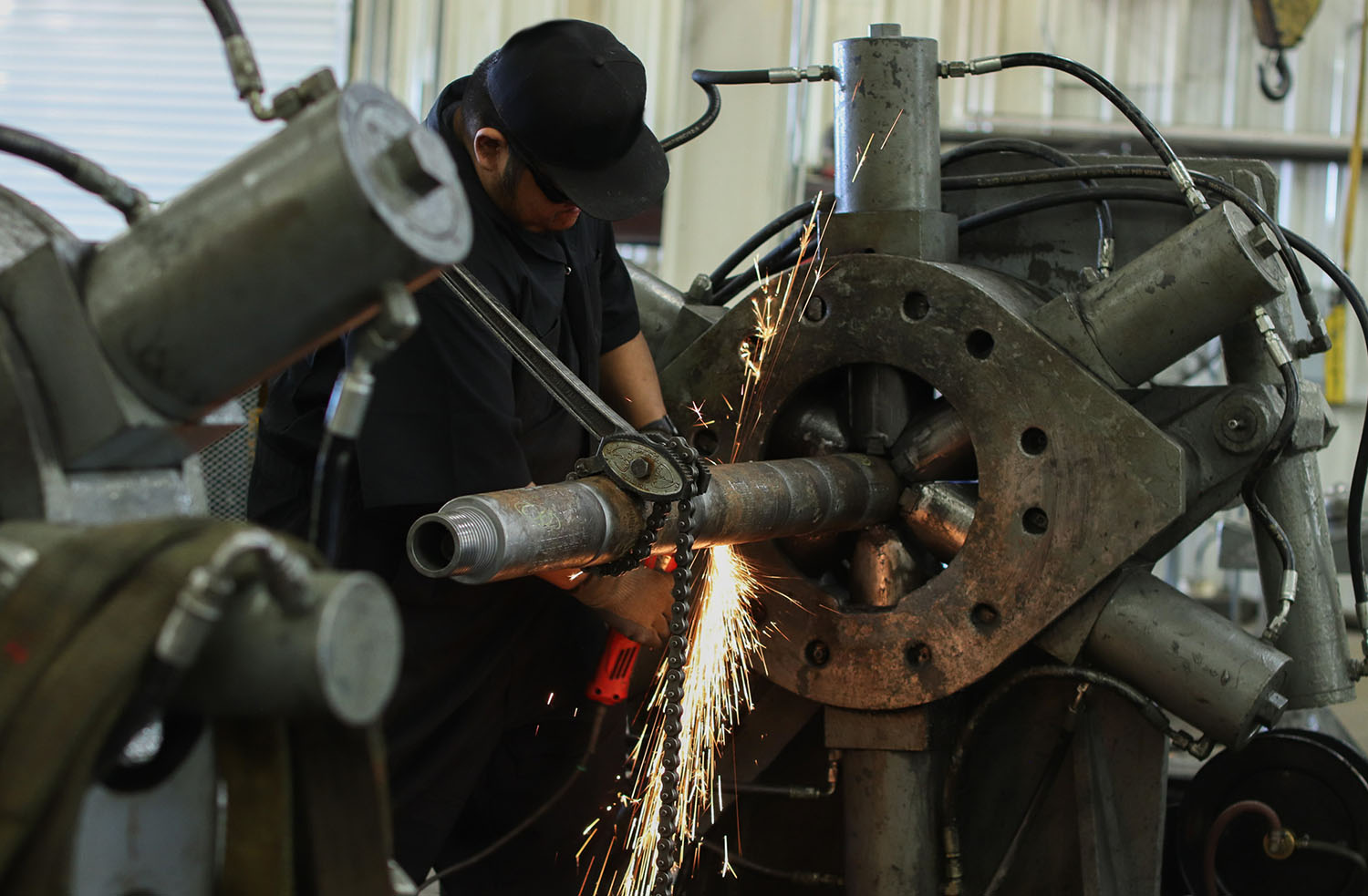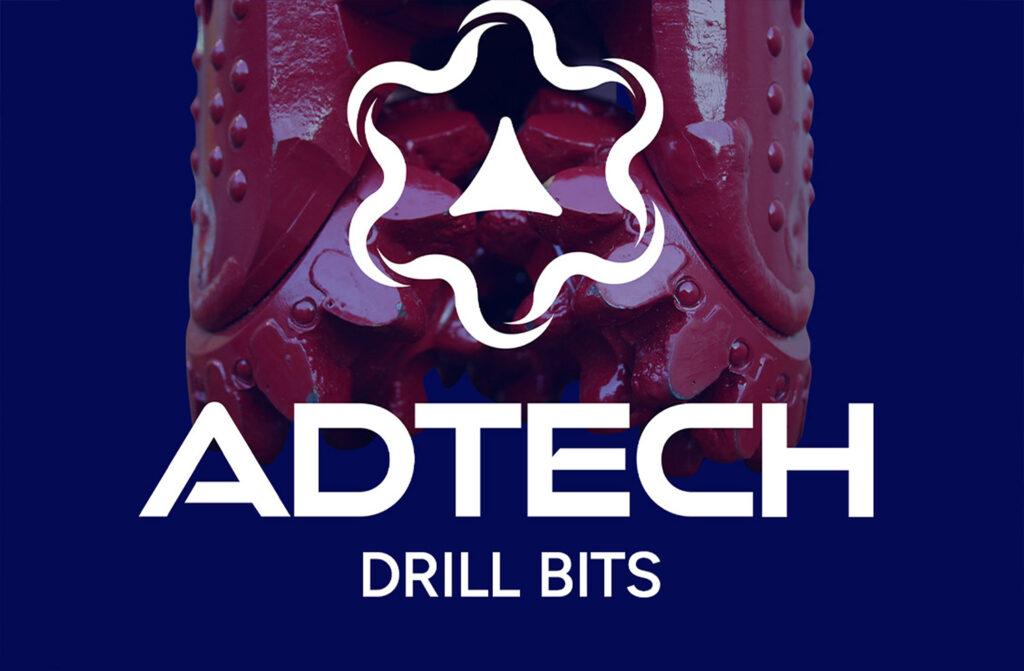Introduction :
The Adtech Downhole Drilling Motor is a positive displacement hydraulic motor/pump powered by drilling rig mud or water. When the fluid is pumped through the tool the bit is turned at a speed proportional to the flow and remains relatively constant regardless of the load or developed horsepower. As weight is added to the motor and the bit start drilling the standpipe pressure will increase in direct proportion to the torque generated. This serves as a built-in indicator as to how the motor is performing, even if wall drag prevents an accurate response of the rig weight indicator.
The Adtech motor offers the following advantages:
Slow Speed:
The motor operates at a speed more compatible with roller bits. This significantly lengthens bit life with increased on bottom time and fewer round trips.
High Torque:
More set down weight can be put on the bit for faster penetration with reserve power for the hard spots.
Oil Filled – Sealed Bearing Section:
Pressure compensated bearing section provides long seal life and more dependable bearing operation. Specialized Designs Adtech motors are specifically designed for the HDD market with advanced sealed bearing sections, oversized bearing packs and thick-walled stators
Design:
All housings of the Adtech motor are tightened with controlled torque (breakout machines) and are locked to minimize accidental backoffs. Prior to shipment out to the field, each tool is thoroughly inspected and tested on our mud pump testing station to guarantee long, trouble-free operation.
Motor Section:
The power section (rotor and stator) is the heart of the Adtech motor. The rotor is double plated with hard chrome to protect it from well bore fluids and abrasion. The stator is molded with an elastomer rubber that also resists the drilling environment. The rotor/stator configuration, stage length, and number of stages determine the speed and torque ratings of the motor. All motor parts are manufactured here at Adtech’s facility including the forming of the rotor and the injection of the rubber into the stator.
Universal Section:
As the rotor rotates within the stator, its center orbits about the centerline of the stator. A double-ended universal joint is used to translate this motion into the pure rotation of the drive shaft.
Bearing Section:
The bearing section supports the weight on the bit and provides rigid lateral stability to the drive shaft. Four heavy duty roller bearings operating in synthetic oil permit high bit load and long bearing life. After assembly of the bearing section, the unit is completely evacuated to test for leaks and then filled with oil. This assures that there is no air in the system and allows the oil to flow freely through and around all of the components of the section. The system is filled under pressure to charge the oil reservoir and (after a topping) operation is bled back a calculated amount to allow for equalization of the oil pressure with the surrounding well bore hydrostatic pressure. This prepressure and pressure compensated oil system assures proper oil lubrication for the seals and bearing operation.
Operation :
The Adtech Downhole Drilling Motor is an easy tool to operate provided it is operated within its design specifications. It should be noted that the specific use of any tool may vary from operator to operator and experience will show the most efficient and safe procedure to follow. It is recommended that a float be run above the tool to keep the bit or other parts of the tool from plugging. Though the tool is built to withstand normal wear and tear, care should be taken while running to depth since damage can occur from hitting bridges, casing shoes, junk or other obstructions in a hole. To run past these tight spots the motor should be operated at its normal speed. If a bent sub is used, the drillpipe (and motor) should be slowly rotated to prevent accidental side tracking of the main hole. As a guide, however the following steps are recommended for routine drilling operations:
Since the speed of the motor is proportional to the fluid volume it is important that the flow rate be accurately set and maintained throughout the drilling operation. When the tool has reached the correct depth and is off bottom, the flow should be set. This will establish the off bottom or no-load pressure the driller sees at the standpipe.
After proper cleaning of the hole, tool orientation, if applicable, should be performed before drilling ahead. As with all downhole drilling motors, the Adtech motor imparts a left-hand torque (tending to tighten the tool joints) into the string above/before the tool. This torque is equal and opposite to the torque generated at the bit while drilling. As weight is slowly added to the motor and the bit starts drilling, the pressure will increase in direct proportion to the torque generated. Assuming everything but the weight on the bit remains constant in any specific drilling situation, the rig pressure gage will be an indicator of the weight on the bit and especially useful piece of telemetry where wall drag prevents an accurate response of the rig weight indicator. If the rig pressure gage does not respond as indicated and the tool does not drill off as predicted, see the section titled Trouble-Shooting. As initial drilling commences a little difficulty may be encountered in getting the tool to drill smoothly. This is due to the bit seating in on the previously drilled formation and will disappear in a short time.
Specifications :
To obtain the best performance from the Adtech Downhole Drilling Motor, it is necessary to use the tool within the specifications and limitations for which it is designed. Care should be used in selecting the right size tool for the right job. Due to the high torque capability of the motor, there may be a tendency to use a tool that is really too small for the job resulting in unsatisfactory performance due to the flow and strength limitations. Tabled below are the general specifications of the motors that are now or soon will become available. These specifications will change from time to time as improvements are incorporated.
Sometimes due to rig or hole conditions it may be necessary to operate with flow rates other than that recommended in the table. Since the listed operating speed of the motor is directly proportional to the flow its change should also be considered. The output torque of the motor is, however, generally independent of the flow and therefore little change of the allowable weight on the bit should be realized. Changing the flow will, of course, change the bit hydraulic horsepower and this coupled with the change in bit speed will in many instances affect the drilling rate of penetration. The tool should never be operated more than 15% above the designed operating flow due to the high pressure drop and flow velocities through the tool. Also operating more than 30% below the recommended flow will result in a lower speed and therefore a decreased rate of penetration and performance. If it is desired to operate below the designed flow, it is recommended that the motor first be started with the designed flow and then adjusted back as required.
Trouble-Shooting :
When drilling is first started, it may take 10-15 minutes for the bit to seat in the previously drilled formation before drilling will proceed smoothly. However, if the motor does not take pressure and drill off as predicted, the following outline may help in correcting the situation. It should be noted though, that most operators have acquired years of experience with drilling motors and have possibly seen every type of malfunction. In each case the operator may use his own particular trick to remedy the problem:
- Is the pump flow rate setting correct? Review Hydraulics section.
- Are the mud pit flow line valves operating and correctly set?
- Is weight getting to the bit? Work the pipe up and down, especially if the pipe is not being rotated.
- Is the bit balling? Again work the pipe and tag bottom lightly to clean.
- Is the tool and bit wedged tightly against the wall of the hole? The use of a high angle bent sub, coupled with a small diameter bit could cause wedging. Work and rotate pipe to free.
- Is the motor sanded-up? An especially dirty hole of faulty float valve could have allowed solids to settle within the motor causing the drilling fluid to channel rather than turn the motor. Continuous pumping (15 minutes maximum) will sometimes correct such a condition. Also during this time slow rotation of the pipe (to the right) while gently tagging bottom will sometimes free the motor.
- If none of the above (or other) corrective actions prove unsuccessful, it will be necessary to trip the tool from the hole. While tripping check for drill pipe and drill collar for washouts to be sure calculated flow was actually getting to the tool. Surface check the tool by pumping through at normal flow rates and watch for normal rotation. If the tool does not rotate pump through for 15 minutes to see if it clears itself. If the motor turns at about half its normal speed check the bypass valve again to be sure that it is actuating freely. Check for anything unusual, as for example, pieces of metal or rubber trapped in the bit, a bent bit sub, etc.
- If the tool still does not perform satisfactorily file a report on the form provided in the lifting sub and return in the sub when wending the tool back for redressing. If you desire the results of the factory tool inspection contact your Adtech representative or indicate on the form enclosed in the lifting sub. Adtech will make every effort to determine exactly the cause of malfunction and provide you with a full report if desired.
Field Servicing :
The bearing section of the Adtech Downhole Drilling Motor has been completely filled with oil at the factory and should not normally require any additional service at location. However, for unusually long runs the oil level should be checked in the field to be sure the bearings are operating with the proper amount of lubrication. More information on checking the oil level may be obtained from your Adtech representative.
Hydraulics :
In operating the Adtech Downhole Drilling Motor, the most important items to watch to assure a successful run are the motor and system hydraulics. It cannot be overemphasized that reliable, high performance will be obtained by close attention to the proper hydraulic requirements. If desired, the Adtech motor can run with diamond bits with one important note. The pressure drop across a diamond bit is caused by friction as the drilling fluid flows between the bit surface and the formation. This pressure drop will vary as the bit is put on bottom and increase as the fluid must pass through the small area between the fluid-courses on the bit and hole itself. In diamond drilling, it should also be noted that the difference in standpipe pressure between drilling and rotating off bottom is due to the pressure increase across the bit and the normal pressure required to produce power by the motor. By subtracting the designed bit pressure drop, the actual motor pressure increase associated with its torque generation can be determined.
Pump Setting :
The Adtech motor, being a positive displacement motor, will run at a specific speed (RPM) for a specific volume (gal/min.) throughout. The required circulation rate as discussed under Specifications should be established prior to drilling and maintained throughout the drilling program for optimum tool performance. For duplex and triplex piston pumps, the flow rate depends on the length of the pump stroke, liner size, number of strokes per minute, and efficiency. For easy reference, the circulation rate for various sizes of pumps is shown in Appendixes F and G. For duplex pumps, these tables were prepared using 95% efficiency for under 40 strokes per minute and 90% efficiency for over 40 strokes per minute. The triplex pump information is shown at 100% efficiency.
Mud Properties :
The Adtech motor is designed to effectively handle most drilling fluids including lost circulation material. However, since the long term performance of the motor depends so heavily on the mud as its source of power more attention will be given to it here. Regular and complete testing of the mud is important not only to the prevention of damage to the motor but also to the success of drilling and maintaining the hole condition as well.
Particular attention should be given to the following items: Lost Circulation Material
As a general rule anything the rig pump can handle can also be handled by the drilling motor. Care should be exercised however in adding these materials to the mud system so that the system is not slugged with large quantities at one time. These could become lodged within the motor or bit passageways. Also it is advisable to run the rig pumps with screens to avoid extra large debris from entering the system. Rags and tools accidentally dropped down the circulating system will severely plug and damage drilling motor.
Sand and Solids Content :
Just like sand and abrasive solids will damage the rig surface equipment the drilling motor will likewise be adversely affected. If possible, desanders should always be used and kept working correctly. Maximum sand content should be no more than 2% by volume with a preferred content of less than 1%. It should be noted that the standard API measurement for sand considers particles only greater than 200 mesh in size. However, smaller particles, depending on their hardness and shape will remove approximately as much material as the courser sand. These finer particles will be found in the solids content of the mud and will have to be removed if present.
Contact Us for more information!
Contact, Email and Call us anytime, 24/7 call answering service will find someone to answer your questions and get you drillin’.
Thank you for the support!




